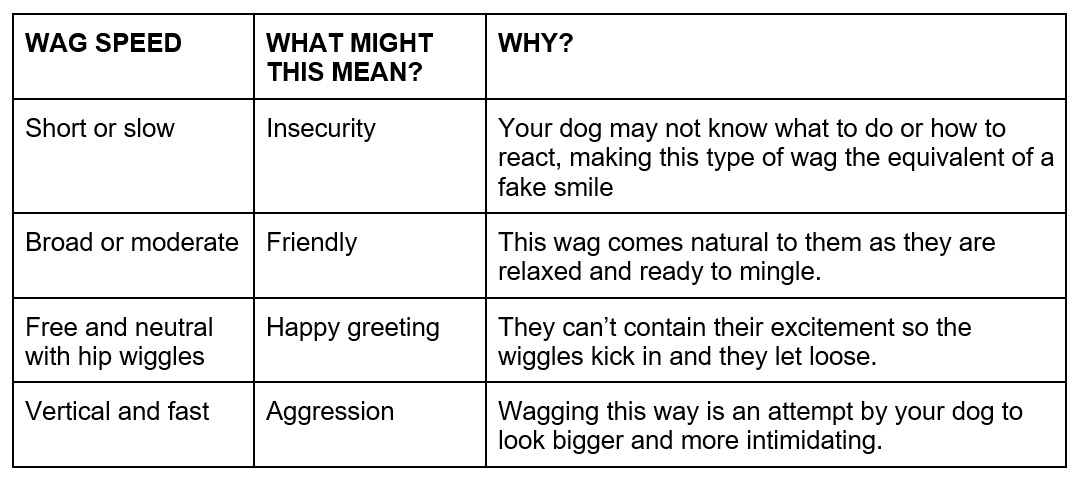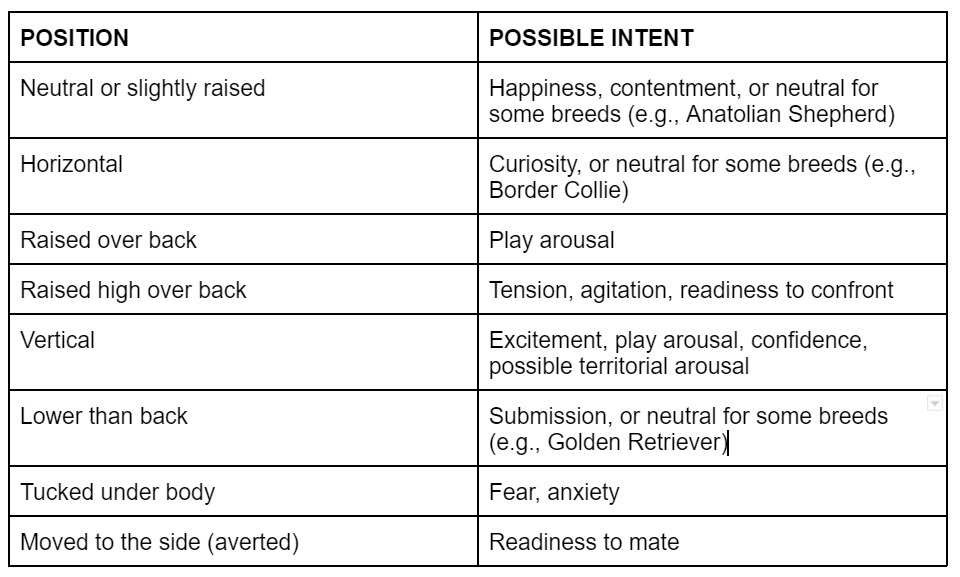Why do dogs wag their tails?
People often ask us what inspired the name “Waggle Mail.”
The verb “to waggle” means “to move or cause to move with short, quick movements from side to side or up and down.”
We felt it was a perfect word to capture the excitement we work to create with our dog subscription boxes: a big, joyful wag from head to tail.
Speaking of tails: why do dogs wag their tails? What does this movement mean?
Let’s find out.
Anatomy of the dog tail
First, a quick anatomy lesson.
EXPERT TIP: Did you know there are almost 10 tail types? From bobbed (born without a tail) to snap (a curly tail that touches the back) to saber (long tails held low in a saber-like shape), tails are further proof of a dog’s individuality.
A dog’s tail is made up of bones, muscles, cartilage, ligaments, blood vessels, and nerve fibres. Because it’s technically a continuation of the spine, the bones within it are called coccygeal vertebrae and are similar to vertebrae in other parts of the spine. These bones vary in structure and shrink in size as you move down the tail, taking on a more cylindrical shape. The nerve fibres (filum terminale) extend to the 6th vertebra; along with muscles, they’re responsible for movement we’ve all come to know and love.
The average length of a dog’s tail is between 15 to 25 vertebrae, but as with shape or type, length can vary from long to virtually (or literally) non-existent.
All tails are good tails.
Understanding the mechanics of a tail is one thing, but what is its function?
Why do dogs have tails?
Of course, not every dog has a tail, but the vast majority do. Tails aren’t just for show—they serve functions that have evolved over time.
Take herding dogs like the Border Collie, for example. They use their tails to stay balanced during sharp turns while herding. Water dogs like Labrador Retrievers, on the other hand, use their tails as a rudder to help them navigate the water.
By far the most popular and prominent function of a dog’s tail is communication. Why do dogs wag their tails? To talk to us and to each other!
How a dog holds their tail can say a lot without having to say anything at all. Other dogs will key in on how that dog is feeling and read into intent. In fact, the direction of a tail wag can also indicate whether a dog is in a positive or a negative frame of mind.
Dogs also wag their tails when they are stimulated or excited. How their tail is positioned during wagging, the wag speed, and the wag direction all provide useful information on what and how they’re feeling. Pretty cool, huh?
The tail is not the whole tale!
Although your dog’s tail can say a lot, we can’t forget about what the rest of our good girl or boy is trying to tell us. Body language is about taking in information from the entire body (head to tail) and not from only one end or the other. Doing so creates a risk we’ll miss a key clue and potentially misinterpret a situation entirely.
It’s also helpful to know how your dog (or its breed) naturally carries the tail when relaxed. Any change from a neutral, relaxed state generally indicates a change in the dog’s internal or external environment. For example, a dog that carries their tail high when relaxed but suddenly drops the tail low may indicate a dramatic change in mood. Less obvious are changes for dogs who carry their tails low. This is why it’s important to get the full picture whenever possible.
Why do dogs wag their tails?
Along with communication, some tail wagging may be a self-soothing behaviour—particularly if you have an anxious pup.
Let’s go back to those three tail qualities (speed, direction, and position) and unpack them a bit.
Wag speed
As a general rule, the faster the wag, the more excited the dog. But remember: excitement can be both positive or negative. Depending on the direction, position, and other body language information, a fast wag can mean either aggression or euphoria.
Not sure how to interpret your dog’s wag speed? This chart may help:

Wag direction
There’s also a lot we can learn from wag direction:
EXPERT TIP: Dogs that tend to left wag more than right may exhibit more anxious behaviours and even an increased heart rate. This is because they associate this sign with confrontation and other negative experiences. Do your best to sort out what’s triggering your dog so you can try to resolve it.
- Wag to the right: Tends to be associated with positive emotions
- Wag to the left: Tends to be associated with negative emotions (uncertainty, anxiety, and even aggression)
If your dog is approaching a new person or place with a left wag, they may be telling you they’re tentative or curious. Or, in cases where your dog doesn’t play well with others, a left wag as they approach a new “friend” may mean they’re on guard (in which case it’s important for you to have your guard up, too).
An enthusiastic helicopter wag, however, tells a different story. This full body wag—what we like to call a waggle—has the tail wagging in a full circle and generally means extreme happiness.
Tail position
Last, but not least, is tail position. Keeping in mind that the tail only tells part of the story, and remembering how your dog tends to hold their tail when relaxed, the following guidelines may be helpful in deciphering why your dog is wagging their tail:

Next, let’s tackle some of the most common questions we hear from dog parents when it comes to situational tail wagging.
Why do dogs wag their tails when they see you?
The answer to this really depends on the dog and your relationship to that dog.
After a day out of the house, you may be welcomed by your dog with an excited tail wag—a loose, hip wiggly wag or a full-body waggle.
If you’re encountering a dog who is less familiar with you, a slow wag with a low or neutral tail position may read as uncertainty or tentativeness.
If you’re greeted with a fast, vertical wag, possibly accompanied with a loud bark or growl, this may mean the dog is feeling threatened in some way and is demonstrating varying degrees of aggression in an attempt to fend you off.
Why do dogs wag their tails in their sleep?
Did you know that the sleep pattern of dogs is so similar to humans that dogs have been used for research into narcolepsy and obstructive sleep apnea? Dogs move through the same sleep stages we do!
During rapid eye movement (REM) sleep, both dogs and humans experience increased brain and eye activity, and are more likely to have vivid dreams. For dogs, these vivid dreams may be behind middle-of-the-night tail wags.
If only we knew what they were dreaming about!
What about dogs that don’t have tails?
There is research to support that dogs with shorter or non-existent tails have a harder time communicating and are often misunderstood by their fellow canines. So why would someone choose to dock (surgically amputate) a dog’s tail?
We are firm believers that tails are an important communication tool that should be left alone without a valid medical reason. We’re not alone in this belief: many countries have banned things like tail docking and ear cropping. Aesthetics isn’t justification for putting a dog at increased risk of being involved in aggressive interactions.
Call us biased, but we think the best way to get your dog’s tail wagging is with a Waggle Mail dog subscription box. Whether your dog prefers to play independently or loves to socialize, we’ll take the information you share to curate boxes of vet-recommended, pet-approved products both of you will love.
Like what you read? Send this article to a friend and subscribe to Waggle (e)Mail. We love answering pet parent questions and demystifying all the funny, strange things our beloved dogs do.

